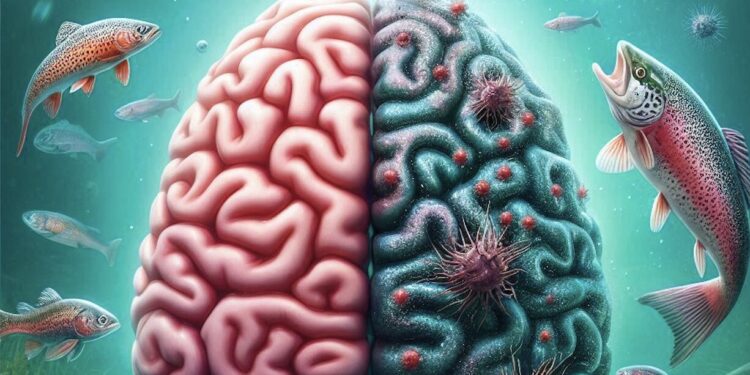Credit: Thalia Stallings/University of New Mexico
Researchers at the University of New Mexico have identified the presence of bacteria in the healthy brains of fish. Understanding this connection between bacteria and animal brains could have future implications for the study of Alzheimer’s disease.
Professor Irene Salinas of UNM has long studied the mucosal immune system in vertebrate animals. His lab, which works primarily with rainbow trout, studies interactions between the immune and nervous systems, a field called neuroimmunology. She focuses on host-microbiota interactions, in other words on how microbes that live in symbiosis with animals modulate nervous and immune functions.
For several years, Salinas’ team has been closely studying neuroimmune interactions in the olfactory-brain axis. In 2019, Ph.D. student Amir Mani joined the Salinas team. Soon, they began to wonder about bacterial impacts on the brain and whether bacteria in the nose could enter the brain. Using previous research as a guide, they quickly realized that healthy fish had bacteria in their blood and other internal organs.
The idea of internal microbiomes is controversial because in humans, bacteria are thought to only enter our bodies when we are sick. However, the team reasoned that fish might be different in that they would allow bacteria to enter their bodies without causing disease. This gave rise to the hypothesis that fish might also have bacteria in their brains, even if they are perfectly healthy.
“Our initial hypothesis was that we might find bacteria in the part of the brain called the olfactory bulb, which is the only part of the brain connected to the nose,” Salinas said. “However, we did not expect to see bacteria in other parts of the brain. In fact, the olfactory bulb was the region with the lowest bacterial loads in the brain.
Their study, “A brain microbiome in salmonids at homeostasis,” published recently in Scientific advancesdescribes in detail the living bacterial community in the brains of healthy salmonids.
Brain bacteria from healthy salmonids are present at a density similar to that in the spleen and, as expected, much lower in the gut. So, where do bacterial communities in the brain come from?
Through computational analyses, the team determined that more than 50% of brain diversity can be attributed to gut and blood bacterial communities. Since blood is constantly circulating in the brain, it is not surprising that bacteria use blood as a means of transportation to reach the fish’s brain.
In the study, the authors were able to visualize bacteria using fluorescence microscopy. Interestingly, some of them have been observed crossing the blood-brain barrier. This supports predictions that blood is likely a very important conduit for bacteria to reach the brain. It also suggests that brain bacteria can be regularly replenished from blood sources at a constant rate.
Although early experiments detected bacterial DNA in trout brains, it was critical to show that these bacteria are alive. Using culturomics, which aims to test as many growth conditions as possible, Mani obtained more than 50 identical bacterial isolates from healthy trout brains in the study.
This bacterial biobank, stored in a freezer in the Salinas laboratory, represents an invaluable resource for any researcher wishing to delve deeper into the functions of these isolates.
“We put a lot of effort into optimizing this to work on blood and microbial tissues to study this finding,” Mani said. “We spent almost two years optimizing the methods used in the study, so we hope this work will help the entire field in future investigations based on our basic work.”
To support their findings on laboratory rainbow trout, the Salinas team sought to sample several other salmonid species from many different locations around the world, including New Mexico’s Gila trout, salmon Oregon chinook in their natural habitat, Norwegian Atlantic salmon and rainbow trout. of the Czech Republic. In all cases, bacteria were found in the brains of these healthy fish, confirming the team’s discovery.
Despite the encouraging results obtained in salmonids, researchers still do not know whether brain microbiomes are present at homeostasis in other fish, other vertebrates or in humans.
“Many others have tried to claim that diseased human brains contain bacteria,” Mani said. “And this has been a real controversy in the Alzheimer’s field because many papers have shown that brain autopsies of Alzheimer’s patients contained certain sets of bacteria in their brains.”
However, studies using human brain autopsies are very difficult to control and it is therefore impossible to exclude contamination during sample collection or due to post-mortem changes. The researchers took every precaution to ensure that the bacteria they recovered from the fish’s brains were actually in the brain and not in an artifact of contamination.
This study is significant because it shows that bacteria are naturally present in the brains of fish without causing damage. This discovery could help scientists better understand how bacteria interact with the brains of other animals, including humans. Researchers believe this could provide insight into diseases like Alzheimer’s, where previous studies have found bacteria in the brains of affected people.
“I think there are a lot of applications for human health, but there are also a lot of really interesting questions we can ask about the importance of this brain microbiota in fundamental fish behavior and physiology,” he said. added Salinas.
The team is currently attempting to seek funding to further support this line of work and is also excited to collaborate with other researchers to continue to answer questions about brain microbiomes.
More information:
Amir Mani et al, A brain microbiome in salmonids at homeostasis, Scientific advances (2024). DOI: 10.1126/sciadv.ado0277
Provided by the University of New Mexico
Quote: Bacteria discovered in the brains of healthy vertebrates suggest a potential role in brain function (October 15, 2024) retrieved October 15, 2024 from
This document is subject to copyright. Except for fair use for private study or research purposes, no part may be reproduced without written permission. The content is provided for informational purposes only.



